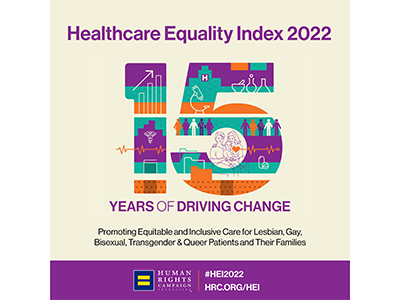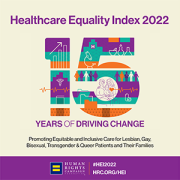Children’s National receives LGBTQ+ Healthcare Equality Leader designation

Children’s National Hospital is one of 496 health care providers nationwide earning coveted “LGBTQ+ Healthcare Equality Leader” designation.
Children’s National Hospital has received a perfect score of 100 and the designation of “LGBTQ+ Healthcare Equality Leader” in the Human Rights Campaign Foundation’s 15th anniversary edition of the Healthcare Equality Index (HEI). This is the nation’s foremost benchmarking survey of health care facilities on policies and practices dedicated to the equitable treatment and inclusion of their LGBTQ+ patients, visitors and employees.
“Our hospital has been on its own journey toward greater diversity, equity and inclusion (DEI) since the early 2000s,” says Denice Cora-Bramble, M.D., M.B.A., chief diversity officer at Children’s National. “Over the past two years we have expanded the scope of our DEI work, which included assessing and improving the care to LGBTQ+ patients as well as the work environment for LGBTQ+ staff. Our improvement efforts are being recognized by this designation.”
The HEI evaluates and scores health care facilities on detailed criteria falling under four central pillars:
- Foundational Policies and Training in LGBTQ+ Patient-Centered Care
- LGBTQ+ Patient Services and Support
- Employee Benefits and Policies
- Patient and Community Engagement
“Every person deserves to have access to quality health care, be respected and heard by their doctor and feel safe in the facility where they are receiving care. But LGBTQ+ people are often subject to discrimination in all spaces, including health care facilities, which leads to members of the community avoiding care and anticipating our voices will not be respected in an incredibly vulnerable environment,” said Tari Hanneman, director of Health & Aging at The Human Rights Campaign. “The HEI, at its core, strives to ensure LGBTQ+ people are protected and affirmed by their health care providers and feel safe seeking services. Our active participants are truly pioneering the health care industry by implementing robust, comprehensive LGBTQ+ inclusive policies that hopefully, because of their work, will become standard practice.”
In addition to active survey participants, the Human Rights Campaign Foundation proactively researched the key policies for LGBTQ+ inclusion at over 1,300 non-participating hospitals. Those hospitals were much less likely to have LGBTQ+ non-discrimination policies in place, which is a stark contrast to the near-perfect adoption by active participants. Among the researched hospitals, in which the Human Rights Campaign Foundation was able to find or obtain enumerated patient non-discrimination policies, only 70% have policies that include both sexual orientation and gender identity compared to 99% of HEI participants.
“We are designing effective, data-driven and responsive programs that will lead to a more diverse, equitable and inclusive workplace,” says George Francois, M.B.A., executive director of the Center for Cancer and Blood Disorders and chair of the Children’s National DEI Program’s LGBTQ+ sub-committee. Francois was a driving force behind the improvement efforts. “More importantly, we are determined to ensure the continued delivery of high-quality health care services to all patients.”





